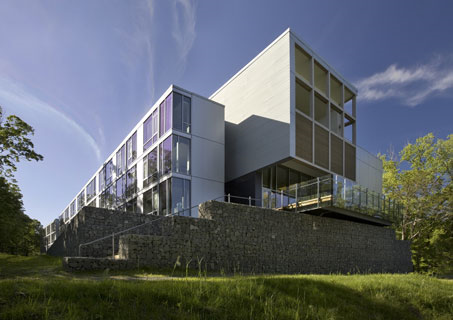New Lamont Geochemistry Building will Address Pressing Questions about Earth

A ribbon cutting ceremony on November 30th marked the opening of the new Gary C. Comer Geochemistry Building at the Lamont-Doherty Earth Observatory in Palisades, NY. The building, made possible by an $18 million gift from Lands' End founder and global climate change activist Gary Comer, is 67,000 square feet, two stories tall and houses more than 70 offices and 30 state-of-the-art laboratories for scientists, students and support staff. The new facility consolidates the geochemistry department, currently scattered across the campus, under one roof.
"The opening of this new building is a landmark event for our faculty at the Lamont-Doherty campus and for Columbia," said Joe Ienuso, Executive Vice President of Columbia University Facilities. "The research that will take place in this new facility will ensure that Columbia remains one of the premier earth and environmental science centers in the world."
Geochemistry is one of our most powerful tools in understanding climate change and global warming. Scientists in the Geochemistry Division work to understand Earth's many complex and interconnected systems by studying the planet's history and the processes that have governed its past and present environment. Geochemists at the Observatory work on a range of projects, from determining the chemical composition and toxicity of pollutants emitted by the collapse of the World Trade Center towers, to revealing clues about past climate changes locked in ice and sediments cores, to identifying the fundamental chemical and physical processes involved in the formation of Earth's mantle and core.
"The opening of this new laboratory facility is an important step towards accelerating our efforts to understand the earth's dynamics and predict our planet's changing climate," said G. Michael Purdy, Director of the Lamont-Doherty Earth Observatory. "The visionary design combines the three primary attributes of a great and effective building: an uncomplicated layout that is driven directly by the specific needs of the researchers; a traffic pattern that will enhance important interactions between the many different groups of users; and environmentally sound and energy-efficient architecture."
In keeping with Columbia University's commitment to develop sustainable projects, the design of the building incorporates a wide array of environmentally friendly concepts that "we hope will result in Silver certification from the Green Building Council's Leadership in Energy and Environmental Design (LEED) program," said Ienuso. "As our first LEED design building, completed with remarkable speed, this facility also demonstrates the University's twin commitments to support cutting-edge environmental research and to house that research within environmentally responsible spaces."
The building's sustainable features comprise every aspect of its design and construction, including site selection that has provided for conservation of trees, vegetation, open space, and wildlife habitat as well as the mitigation of impact on the Hudson River, Palisades Interstate Park and Lamont Nature Sanctuary view sheds. Porous pavement and infiltration systems collect storm water from the roof and parking lot, reducing runoff by 20 percent and providing 100 percent soil contact for pollutant removal. Water conservation includes the use of ultra-low-flow plumbing fixtures and irrigation-free landscaping. Besides the shuttle service between the Morningside campus and LDEO, the building is close to public transportation, has bike racks and showers, and will provide preferred parking spaces for fuel-efficient vehicles and car pools. The building has an air conditioning system that uses high efficiency chillers with non-depleting refrigerants, natural ventilation for offices, occupancy sensors to control lighting and temperatures, energy recovery from the ventilation system, daylight harvesting and high efficiency light fixtures. Ninety percent of the building's occupied spaces will have daylight and views.
While focusing on sensible, effective and innovative sustainable design strategies, the design team also incorporated standards outlined by the Labs21 Approach, a voluntary program sponsored by the Environmental Protection Agency and the U.S. Department of Energy to improve the energy efficiency and environmental performance of laboratories.
From design to ribbon cutting, this project was completed in the shortest amount of time of any project in recent history and set a new standard for successful project management at Columbia University Facilities. Congratulations to the many members of the project team that made this project possible, including: John Echeverria (Project Manager), Sean Joyner and Doug McKean (Program Directors), Irwin Lefkowitz (University Architect), Frances Huppert (AVP of Capital Project Management), Payette Associates (Architect), Torcon (Construction Manager), Jeffrey Sachs (Director, The Earth Institute), G. Michael Purdy (Director, Lamont-Doherty Earth Observatory) Patrick O'Reilly (LDEO Assistant Director of Facilities, LDEO) and all of the members of the Geochemistry Building Committee.